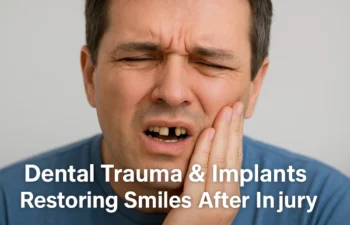
Dental trauma can happen in an instant — from a sports injury, a fall, or even biting down on something hard. In many cases, the damage goes deeper than what’s visible on the surface. One of our recent patients experienced this firsthand: after a traumatic incident years ago, a front tooth became necrotic (non-vital) and developed a short root that could no longer support a crown. The solution? A dental implant that restored both function and aesthetics — permanently.
Common Types of Dental Trauma
Dental trauma refers to injuries to the teeth, gums, or supporting bone structure. According to the Centers for Disease Control and Prevention (CDC), dental injuries are among the most common types of facial trauma seen in emergency rooms. Here are some common examples:
- Fractured or chipped teeth – Often caused by contact sports or accidents. Example: Biting down on a hard popcorn kernel or getting hit in the mouth with a basketball.
- Luxation injuries (tooth displacement) – The tooth is loosened or pushed out of alignment. Example: A slip-and-fall where the mouth hits the ground or a steering wheel during a car accident.
- Avulsion (tooth knocked out) – A complete dislodgment of the tooth from its socket. Example: A child’s front tooth gets knocked out from a bike crash or playground fall.
- Root resorption or necrosis – Sometimes, trauma doesn’t show symptoms right away. Over time, the nerve can die (pulp necrosis), or the root can shorten, making the tooth unstable — as in our patient’s case. Example: Years after an elbow to the mouth during sports, the tooth begins to darken and loosen.
(Source: CDC – Oral Health Conditions)
When a Tooth Can’t Be Saved
While root canal therapy and bonding can treat many traumatic injuries, there are cases where the damage is too extensive — particularly when the tooth root is too short or necrotic. When this happens, extraction is often the only option.
Fortunately, modern implant dentistry allows us to replace the missing tooth with a titanium implant, which integrates with the bone to act as a stable, long-term replacement root.
How Dental Implants Restore Health and Appearance
Dental implants are considered the gold standard for replacing missing or non-restorable teeth. Here’s why:
- Bone preservation: Implants stimulate the jawbone and prevent bone loss that follows tooth extraction.
- Longevity: With proper care, implants can last decades — far longer than bridges or dentures.
- Aesthetics: They’re customized to match the size, shape, and color of your natural teeth.
- Confidence: Patients can smile, speak, and eat comfortably again — without worrying about movement or discomfort.
(Source: American Association of Oral and Maxillofacial Surgeons – Dental Implant Information)
Preventing Dental Trauma
Although not every accident is avoidable, there are ways to reduce risk:
- Wear a mouthguard when playing contact sports or activities with fall risks.
- Avoid using teeth as tools (to open packages or bottles).
- Seek prompt treatment after an injury, even if it seems minor — internal damage may not be visible immediately.
Restoring Smiles After Trauma
Dental trauma can be stressful, both physically and emotionally, but with advanced implant technology, full restoration is possible. Whether it’s a single lost tooth or multiple damaged teeth, our experienced team can design a customized treatment plan that rebuilds your smile’s strength and beauty — for life.
If you’ve suffered from a past dental injury or are experiencing pain in a tooth that previously suffered trauma, schedule a consultation at Creative Dentistry & Medspa.
Posted on behalf of Creative Dentistry & MedSpa

